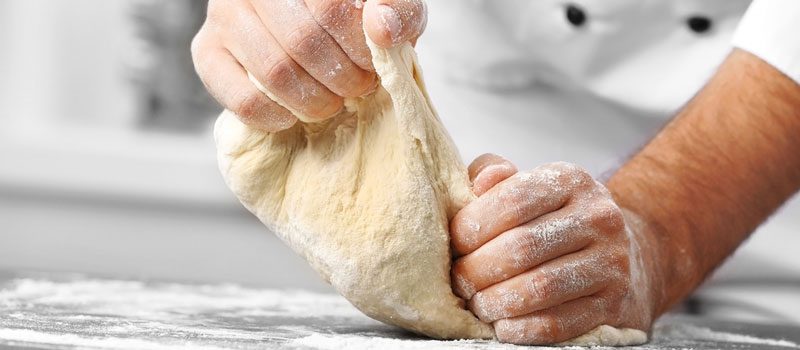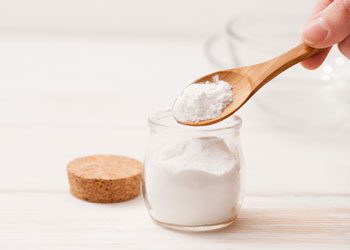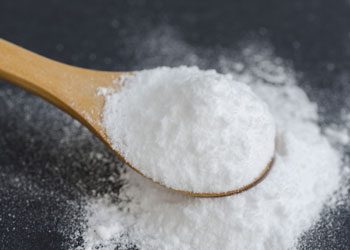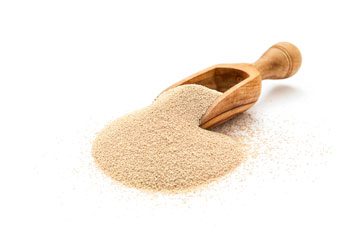When making pizza or bread dough, you can use baking soda in place of powder. It’s preferable to combine baking soda and baking powder while making pizza dough—mix one tablespoon of baking powder with baking soda to create the perfect pizza dough without yeast.

Why use Baking Soda in Pizza Dough?
Though yeast-based dough is most commonly used for pizza, some individuals keep yeast on hand. As a result, baking soda for pizza dough is the best next option for making any pizza.
The leavening process is also faster than waiting for the yeast to rise, but the texture and flavor are the same.
Additionally, baking soda on pizza dough can increase the dough’s oven spring.
However, too much baking soda in the dough can result in a metallic aftertaste.
Can I add baking soda to the pizza dough?
Yes, Baking soda can use to make pizza dough. Place your flour in a bowl and set it aside before adding baking soda to your pizza dough. Combine the flour, lemon, and baking soda in a large mixing bowl.
It’s an excellent yeast alternative, and all you have to do is mix equal parts lemon and baking soda once you get the desired amount of yeast.
What does baking soda do for pizza dough?
In the acid component, the most common components are sodium aluminum phosphate and baking soda. As a result, more leavening gas is produced in the initial few minutes of baking since it takes longer to react. As a result, it has more oven springs when the dough is baked.
Baking Soda vs. Baking Powder vs. Yeast
Whether baking powder, baking soda or yeast, these ingredients contain leavening agents that help the dough batter rise in baked foods. In the baking process, all three components are frequently misinterpreted for one. Even though they have similar effects, they are all different.
As a result, it’s essential to understand how each of these elements interacts with the others and how they affect the final recipe. I will define each of these three components separately to see the differences.
Baking Soda
Baking soda is a typical leavening agent found in many different baked goods. It’s the key component of baking strength. When used as a base in baked goods, baking soda reacts with any acids it comes into contact with. Tiny gaseous carbon dioxide bubbles are produced when baking soda and acid are combined because of the alkaline chemical component in baking soda.

Baking soda not only leavens the dough but also raises the pH level. Compared to baking soda and baking powder, Baking soda is four times stronger than baking powder. A modest bit of baking soda will suffice when using it to make pizza dough.
Baking soda differs from yeast because it produces carbon dioxide gas and immediately expels it. It expands and becomes hard when exposed to heat.
Baking powder or yeast is typically substituted for baking soda when a recipe calls for a prolonged chemical reaction, such as dough rising, rather than a quick release. Baking soda is commonly used for quick foundation foods such as pancakes, scones, and muffins due to the speedy nature of the gas bubbles.
Baking Powder
Baking powder contains various ingredients, including baking soda, cornstarch, and cream of tartar. Baking powder can use in recipes that do not require other acids, such as vinegar, lemon, or cream of tartar.

Moreover, while baking powder is most comparable to yeast in leavening baked items, they act differently. If you substitute baking powder for yeast in the pizza dough, the dough will be less chewy and yeasty in flavor. Yet, baking powder is the most acceptable option for making pizza crust.
Yeast
Yeast is a living organism that takes far longer to leaven dough than either baking soda or baking powder. A biological process causes the yeast to leave the dough, resulting in fermentation. Yeast also affects the flavor of the bread, making it an excellent choice for dough and bread.

The dough can rise and generate a gluten-free taste because yeast includes alcohol byproducts, CO2, and sugar. Yeast is necessary for the dough to increase and enhance the dough’s elasticity, making the pizza dough fluffier and chewier.
Leavening Pizza Dough
Traditional methods of leavening pizza dough include kneading, pounding, proving, and finally re-proving. Pushing down and a second proof is optional when using baking soda and powder.
Only a small portion of the yeast’s time is required for the first proof. The pizza dough will continue to rise because of the tiny carbon dioxide air bubbles.
Substituting
To make baking powder, combine the cream of tartar, baking soda, and cornstarch in a small mixing bowl. The ratio of cornstarch to baking powder should be 1 part cornstarch to 2 parts cream of tartar to 1 part baking soda for every four parts of baking powder is recommended. These should add at the same time as the meat.
If you don’t have them on hand, simply add a small quantity of acid to the wet components of the pizza dough when mixing the baking soda with the dry. If a dough recipe specifies milk, substitute buttermilk and adds the acid to the mix without changing the proportions.
Consideration
Unless you use the appropriate quantity of baking soda, you won’t be able to taste it in pizza flour. Use flour to cover a minor excess of oregano, sage, basil, or rosemary.
To add sweetness, you can also add caramelized onion and garlic. Drizzle chopped dried tomatoes with oil or pesto flour for a simple way to add more flavor.
Final Verdict
Pizza became one of our favorite foods, so we’d often make it at home. As a result, if we don’t have all of the ingredients for pizza at home, we’re looking at other methods of making it. Also, in the absence of yeast, we’re constantly looking for new ways to cook pizza, although we’re used to doing so.
In today’s article, I answered this question. In addition to this explanation, you will discover some further facts about pizza in this post. Hopefully, it will help you in making your next pizza.
